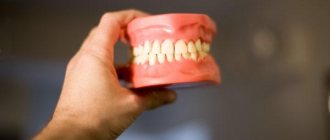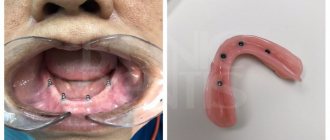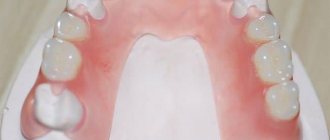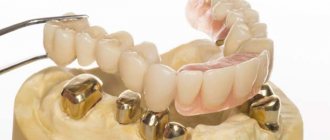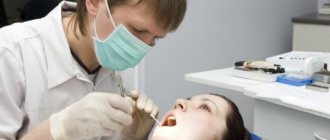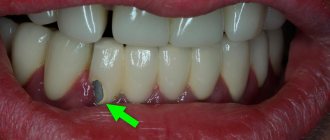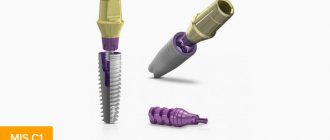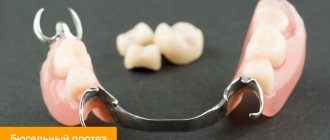Fixed dentures - features and advantages
Fixed dentures are considered the most effective and inexpensive solution to restore dentition.
The most common causes of tooth decay and subsequent loss are:
- abundant carious lesions;
- pulpitis;
- periodontitis;
- dental cysts, etc.
As a result of these dental diseases, tooth crowns and roots are destroyed, teeth fall out on their own, or surgical intervention is required to remove dead hard tissues and roots. For restoration, the dentist recommends permanent dental prosthetics, the basis of which is a bridge and ceramic crowns of the latest generation.
Advantages of fixed dentures:
- Aesthetics. Fixed dentures are difficult to distinguish from your teeth. With proper selection and proper installation, the design looks harmonious in the oral cavity, and the person smiles boldly.
- Comfort. A person quickly gets used to a fixed denture and does not feel discomfort afterwards.
- There is no need to build up bone for high-quality implementation of a fixed denture. When using modern artificial roots, there is often no need to build up bone tissue. This simplifies the entire dental procedure and makes it much more affordable.
- Fast payback. The investment in fixed dentures always pays off in dental health, attractive visual effect and durability.
Types of permanent dental prosthetics
Fixed dentures include crowns and bridges made of metal ceramics and zirconium dioxide. The support for this type of orthopedic products can be teeth or dental implants. To restore the visible surface of a tooth, it is no longer necessary to grind the entire tooth. You can treat only the front surface of the tooth or restore it with a veneer (inlay) made of zirconium dioxide.
If it is necessary to restore a tooth that has been completely destroyed down to the base of the root, there is a technology that allows this restoration to be carried out using a core inlay made of both metal and ceramic.
Another type of ceramic inlay can be used for artistic restoration of a severely damaged crown of the lateral group of teeth.
Prosthetics on implants can be performed after implantation, on average, after 4-6 months. At the same time, prosthetics with Swiss Straumann implants can be performed within 4 weeks.
For permanent prosthetics of a toothless jaw, it is possible to use the technology of complex dental implantation with subsequent prosthetics to restore the dentition using four to seven dental implants. Modern technologies make it possible to successfully carry out fixed prosthetics with the specified number of implants.
[]
The main types of permanent dental crowns
At the stage of planning treatment with a fixed denture, the dentist, together with the patient, decides which type of fixed dental crown to use for high-quality prosthetics.
Currently, the most common fixed dentures are:
- Teeth crowns
They are used if the hard tissues of your tooth are destroyed by more than 2/3. The implementation of this type of fixed dental prosthetics occurs as follows:
- the tooth is strengthened with a supporting core and a fiberglass dental pin;
- the tooth is ground down;
- the dentist makes impressions of the tooth;
- After a week or two, a ceramic crown or one made of metal ceramics, plastic, zirconium dioxide, etc. “sits” on your tooth.
- a person receives a new healthy tooth that does not differ from his own either visually or in functional characteristics.
- Veneers – as a type of fixed denture
- their teeth are prepared;
- a thin ceramic onlay is fixed on the surface of pre-selected teeth;
- within a few hours the patient receives an impeccable effect - even, snow-white and beautiful teeth.
A veneer is a thin ceramic inlay that perfectly matches the shape, color, and transparency of your tooth. Such a fixed denture “sits” with the help of a special dental glue on the front wall of a previously ground tooth. Recently, super-thin permanent dental veneers have appeared, which practically do not require grinding of their crown, do not stick out, and look organic. As a rule, veneers are placed on the front six to ten teeth of the upper jaw (smile area). If the lower teeth are in good condition, whitening them is enough to achieve the ideal effect.
Installation of fixed dentures and veneers occurs as follows:
The average lifespan of veneers with proper use is up to 10 years.
Restoring ceramic inlays are used when more than ½ of the tooth crown is destroyed. Dental micro dentures are made from individual dental impressions in dental laboratories, fixed using a special dental bond, and prevent the occurrence of recurrent caries on the teeth.
Advantages of ceramic inlays (mini dentures) compared to composite fillings:
- high strength;
- durability of teeth (on average, from 3 years);
- ceramic systems do not absorb pigments and do not darken;
- retain their qualities throughout the entire period of validity.
Technique for predictable removal of cemented implant-supported dentures
Show menu
- Lectures
- Conferences
- Courses
- Publications/Scientific work
- Abstracts of foreign articles
Abstract compiled by: Abstract compiled by: Bisyaev G.K.
Schweitzer DM, Berg RW, Mancia GO. A technique for retrieval of cement-retained implant-supported prostheses // J Prosthet Dent., 2011.-Vol.106(2).-P.134-8.
The ability to remove prostheses is an important aspect of treatment due to potentially unpredictable biological or mechanical complications. Cement-retained implant-supported dentures with predictable removability increase the clinician's ability to care for, repair, and, if necessary, replace these dentures. The procedure can be performed on either custom abutments or factory abutments for single or bridge restorations. This technique requires metal at the interface between the abutment and the crown and involves the use of a flathead screwdriver to facilitate removal of the prosthesis.
Technique. Make a model of self-polymerizing acrylic resin for a castable screw-retained abutment, with the ideal dimensions of the prepared tooth (Fig. 1). Make a lingual-palatal shoulder approximately 1 mm above the gingiva and follow the contour of the gingival margin (Fig. 2). Mill the lingual-palatal groove in the abutment (Fig. 3).
Prepare a slot at least 1 mm deep and 3 mm wide (mesiodistal), creating enough space to insert the functional tip of a flathead screwdriver to be used for removal (Figure 4). Pack and cast a custom type 4 gold alloy abutment. After unpacking and cleaning, mill the custom abutment to the ideal size and shape using a milling machine, then sand and polish it. Make a substructure of self-polymerizing resin over the custom abutment with a minimum thickness of 0.5 mm. Heat the functional tip of the screwdriver over a fire and place it within the light wax along the length of the abutment arm. Apply pressure until it contacts the axial wall of the milled abutment (Figure 5), creating an open crown edge that is approximately the size of a screwdriver (Figure 6).
Clean, pack and cast gold alloy wax modeling for cermets. Immediately after casting, unpack and process the frame. Apply ceramic as usual. After fitting, fitting and final polishing, secure the denture intraorally with cement. Remove excess cement from everywhere, including the groove. Fill the groove with resilient composite material (Fig. 7).
To remove the denture, remove (if necessary) excess composite material from the groove using hand tools such as a scaler or probe. Then install a flat-head screwdriver with a torque wrench into the groove, press with your finger and apply a force of 32 Ncm while controlling the force. The cement will break and the prosthesis will be removed (Fig. 8, 9).
Discussion
. The presented technique describes the production of cemented prostheses on implants with predictable removal. The release slot allows the flathead screwdriver, when rotated in the slot, to simultaneously apply force coronally away from the abutment and an apical force onto the abutment sufficient to break the cement and separate the two components. Also, the groove can be placed in the area of the angle of the mesiolingual line of the lateral crowns to improve clinical access. During bridge fabrication, this type of crown removal mechanism can be incorporated into multiple parallel milled abutments with a convergence of 4 to 6 degrees each to allow successful removal of the prosthesis when necessary (Figure 10). To remove the bridge, the grooves can be used one at a time to ultimately destroy the entire cement layer (Fig. 11,12). The use of higher hardness gold-containing alloys for the custom abutment and for the prosthetic framework helps in preventing significant distortion of the groove. These alloys are also more resistant to corrosion and have less potential for local toxicity to the tissue around the implant.
Conclusion. The predictability of removal of cemented implant-retained prostheses is a clinical problem. The presented technique includes a design feature that allows these prostheses to be easily and predictably removed to facilitate required maintenance and repair or replacement of the prosthesis by the physician.
Classic dental bridge or fixed dental bridge
A classic bridge is a one-piece denture structure consisting of a base, as well as functional and supporting crowns. Functional crowns replace lost teeth, and abutment crowns serve as the basis for securely holding a fixed denture in the oral cavity.
Why do patients choose dental bridges?
- Deadlines. Prompt production of individual impressions in a dental laboratory - up to 14 working hours. days. With additional payment and comfortable conditions, it is possible to produce a fixed denture in 3–5 days.
- Indications for implantation. A fixed dental prosthesis is an excellent replacement system for diagnoses where there are restrictions on the implementation of titanium dental implants and the installation of crowns on these artificial roots.
- Price. The cost of a classic bridge is several times cheaper than the price of a titanium implant and a metal-ceramic or zirconium dioxide crown.
- No age restrictions. Bridges are often staged for both older people and middle-aged audiences.
The nuances of using a dental bridge with pre-implantation:
- You have to grind down your supporting teeth, albeit a little;
- It is often necessary to first remove the roots of the teeth before implantation.
Manufacturing of fixed orthopedic products using innovative technology “3 SHAPE” (Denmark)
Modern dental practice is armed with various technologies that make it possible to produce permanent dentures. Prosthetics can be performed in the presence of a decayed tooth or in the absence of several teeth with the production of ceramic veneers, crowns or bridges made of zirconium dioxide or e.max.
However, the question remains about the quality of manufacture of these structures, their shape and color. In a number of clinical cases, individual errors in the work of doctors or technicians were noted, which lead to a violation of the desired tooth shape or to irrational closure of the teeth. All this is very unpleasant and worsens the quality of life of patients.
The same mistakes can be made by insufficiently qualified specialists when applying crowns to dental implants. All this can happen even if the doctor or technician is very attentive to the treatment being carried out. This is due to the human factor.
In order to avoid the errors inherent in a number of specialists in this or that case, special computer technologies were developed for scanning teeth prepared for crowns or veneers, eliminating the need to work with impressions and determine the bite. In other words, these technologies completely isolate the doctor and technician from technical manual work according to the specified parameters.
One of the modern innovative systems that allows such scanning in the oral cavity and provides a perfect orthopedic design for both teeth and dental implants is the 3SHAPE prosthetic technology (Denmark).
This cutting-edge program means you no longer have to take impressions in your mouth or worry about how a technician will model a zirconia or E-max crown or veneer. All these moments are carried out by a high-precision scanner, which transmits images of teeth and implants to a computer in a dental laboratory, followed by milling of a crown or veneer or inlay in a computer contour according to the desired and optimal shape.
The most important thing is that this computer technology will not miss the possibility of making dentures if there is even a minimal error during scanning.
[]
Author of the article:
Prikuls Vladislav Frantsevich
Head of the Swiss dental implantation center "DentaLand", dentist, Doctor of Medical Sciences, Honored Doctor of the Russian Federation.
Clinical experience 33 years .
+7 (495) 085-85-99
Online registration
Share link:
Adhesive fixed bridge prosthesis
An adhesive fixed denture got its name due to the peculiarities of fixation on the supporting teeth. To connect it with living tooth tissues, adhesion is used, that is, “sticking” technology. For reliable bonding, the prosthetist uses a dental primer, bond, some types of acids (for example, phosphoric acid), chemical or light-curing cement.
Adhesion helps to secure the ceramic tooth and onlay processes to the supporting teeth without removing the roots and grinding away a large layer of its enamel.
Structure of an adhesive dental bridge:
- main abutment tooth;
- side linings in the form of processes (petals), onto which a fixing compound is applied.
The average lifespan of an adhesive dental bridge is up to five years.
Free consultation
Our specialists will conduct a free consultation and select the best treatment option for you.
Sign up now! Online registration
+7 (495) 649-41-19
Crowns for teeth
The ideal option for restoring one damaged tooth that cannot be filled is a crown. In this case, the dental unit is initially prepared, then an impression is made for the purpose of further recreating the crown. At the third stage, temporary prosthetics are performed. The final procedure is the installation of a permanent prosthesis.
The following crown options are available:
- Made from metal alloy. They are famous for their ideal strength and reliability indicators. However, they do not have the required aesthetics, which excludes the possibility of use in the frontal zone;
- Ceramic. They are presented by a combination of ceramic material and zirconium base. They are distinguished by precision in manufacturing, do not cause allergic reactions, can be used for a long period and have unsurpassed aesthetic parameters. The disadvantages include fragility. In addition, when such a fixed denture is installed on the lower or upper jaw, its price in mid-segment clinics is often considered overpriced;
- Made from metal ceramics. They are represented by a combination of a ceramic layer and a metal interior. They are among the most durable and durable products, which, moreover, have excellent aesthetic qualities;
- Adhesive. They play the role of a temporary structure due to the lack of sufficient strength and reliability indicators. The production is based on the use of fiberglass and photopolymer materials. This design is inexpensive and the process takes place in one visit to the dentist.
When it comes to how much it costs to install these fixed dentures, crowns made of metal and metal-ceramics are in the most advantageous position. Moreover, in order to fix them, it is not necessary to heavily prepare natural dental units. Ceramic crowns allow you to recreate the natural shade of enamel and maintain the necessary transparency. But, when choosing such new generation fixed dentures, remember that their price in Moscow remains quite high compared to other prosthetic options.
Zirconium crowns, read more > Metal-ceramic crown, read more >
| Service | Price, ₽. |
| Consultation with an orthopedist | for free |
| Orthopantomogram - panoramic image of teeth | 950 |
| Ceramic crown Dutseram plus (Germany) | 20 500 |
| Ceramic crown made of zirconium dioxide | 35 000 25 000 |
| Empress crown | 19 000 |
| Ceramic crown made of zirconium dioxide on an implant | 35 000 |
| Temporary plastic crown/wedge. | 2300/1500 |
| Taking an impression from alginate mass | 400 |
| Diagnostic plaster model | 400 |
| Taking a double impression | 800 |
| Cementing inlays and crowns using Fuji cement | 700 |
| Cementing inlays and crowns using Fuji+ cement | 800 |
| Temporary cementation of one crown | 400 |
| Removing one crown with stamped sawing | 500 |
| Removing one crown with sawing the cast | 1 000 |
| Removing one crown with sawing MK | 800 |
Features of installation of bridge structures
As stated earlier, if two or more teeth are lost, it is advisable to use bridge structures. Their production is based on the same methods and materials used in relation to other fixed prostheses. At the same time, among the best are products made from metal-ceramics and ceramics. They are presented in two versions:
- The nearby dental units serve as the base. They are distinguished by durable fastening, since they are created on the basis of impressions;
- The function of the supporting element is performed by the implant. They allow you to restore the natural beauty of your smile and restore chewing parameters in the absence of all dental units.
Fixed denture on implants
The most priority and relevant method of prosthetics in modern times is the use of implants. A clear advantage of this technique is the ability to provide the necessary load on the gums, restore chewing characteristics and restore aesthetics.
At the initial stage of implantation, a metal rod is implanted into the bone. Next, an element is installed for the correct formation of the gingival margin. After this, they proceed to the implantation of a special adapter, which is subsequently used to fix the prosthesis.
Read more >
The following materials may be used in the implant production process:
- Titanium alloy. It is considered the most popular among modern patients, due to its increased ductility and strength. In addition, this material does not darken over time and has excellent survival rate;
- Zirconium material. During the manufacturing process, a special computer program is used, which allows you to recreate the basic parameters of the tooth with maximum accuracy. It is considered a hypoallergenic material and does not cause rejection;
- Cobalt-chrome alloy. It can be used for 10 years, but does not have the required aesthetic components. Used for restoration of the chewing area;
- Metal-ceramic material. It can be used to restore frontal teeth, as it is able to convey their natural shade. It is famous for its resistance to impacts, has extreme strength and has a long service life. The only “minus” is that the mounting location may become noticeable against the general background over time;
- Porcelain. Does not change shade over time, is resistant to temperature changes, but has insufficient strength compared to the previous material.
It should be noted that when fixed dentures on implants are considered, their prices are considered the highest among all other types of prosthetics. This is due to the complexity of the work performed and the high cost of the materials used.
By contacting the Elident clinic, each patient can count on loyal prices, an individual approach to the problem and high professionalism of specialists.
| Service | Price, ₽. |
| Consultation with an orthopedist | for free |
| Orthopantomogram - panoramic image of teeth | 950 |
| Metal-ceramic crown on an implant | 19 500 |
| Ceramic crown made of zirconium dioxide on an implant | 35 000 |
| Temporary plastic crown/wedge. | 2300/1500 |
| Clamer spraying | 1 500 |
| Spraying the crown | 1 500 |
| Taking an impression from alginate mass | 400 |
| Diagnostic plaster model | 400 |
| Taking a double impression | 800 |
| Temporary cementation of one crown | 400 |
| Removing one crown with stamped sawing | 500 |
| Removing one crown with sawing the cast | 1 000 |
| Removing one crown with sawing MK | 800 |
| Installation of an abutment on an Alpha Bio, BioLine, Osstem implant | 6 500 |
| Installation of an abutment on a Straumann implant | 8 500 |
| Installation of a zirconium oxide abutment on a Straumann implant | 18 500 |
| Installation of abutment on zirconium oxide on an Alpha Bio, BioLine, Osstem implant | 17 000 |
Fixed denture on titanium implants
Fixed dentures on dental implants are one of the most common systems for restoring lost teeth.
The main advantages of such solutions:
- titanium implants installed in deep bone layers preserve hard tissue around them;
- healthy supporting teeth do not require preliminary grinding and root removal;
- the average shelf life of such dentures on artificial roots is twenty years;
- the method of restoring teeth with fixed dentures is considered the most gentle and natural;
- ready-made solution for restoring edentulous teeth;
- attractive dental aesthetics.
The only caveat when installing a fixed dental structure on implants is the considerable cost of the solution.
If we compare all the existing options for fixed dental prosthetics, it is the fixed prosthesis on a dental implant that is the best solution - in terms of quality, aesthetics, reliability and durability of the teeth.
Care of fixed structures
Fixed dentures need to be cared for in the same way as real teeth. In order for them to serve to the maximum without losing their aesthetic qualities, it is necessary to carry out a number of measures:
- give up bad habits and products that can damage dentures;
- protect prostheses from mechanical damage (install mouthguards in case of pathological grinding, as well as when playing sports);
- limit the consumption of coloring products to avoid discoloration of dentures;
- Attend routine dental appointments.
How to care for fixed dentures?
Basic rules for proper care of fixed dentures at home:
- brushing teeth with a brush and dental floss;
- using a dental irrigator (preferably after every meal);
- hygienic cleaning of the tongue.
- preventive visits to the dentist’s office (at least twice a year) to control the quality, reliability of fastening and aesthetics of a fixed dental prosthesis (bridge);
Don't forget to clean the surface of your tongue, where just as many bacteria accumulate as on your teeth and gums. These organisms provoke the development of caries. To clean your tongue at home, use a hygienic scraper with a rough surface, which can be purchased at a clinic or any pharmacy.
If the patient wears fixed dental prostheses made of metal-ceramics or ceramic crowns, experts recommend checking the so-called supercontacts (heightened areas of the bridge) at least 2 times a year and grinding them to avoid chips and mechanical damage to the dental bridge.
If you feel that the bridge or individual teeth have begun to loosen, you should urgently consult a dentist. In case of mechanical damage to a fixed denture, the defects can be eliminated without replacing the structure with a new one. If you lose time, you will have to resort to dental prosthetics again using a new bridge.
Removable dentures made of nylon –
These are so-called soft removable dentures, made of elastic nylon (Fig. 13-15).
They are used for both complete and partial absence of teeth. Thanks to the properties of nylon, dentures made from this material can be made thinner and lighter than dentures made from plastic. In addition, nylon has a high degree of elasticity and flexibility, which makes these prostheses more comfortable to wear. In addition, removable dentures made of nylon have very good aesthetics and are practically invisible in the oral cavity. This is due to the fact that the gingival clasps of the nylon prosthesis (necessary for its fixation) are also made of pink nylon, which makes them invisible against the background of the pink shell of the gums. In turn, in plastic and clasp dentures the clasps are made of metal, and therefore they are clearly visible when they are in the smile line.
Dentures: photo
However, this is where the positive properties of such prostheses end. Reviews of nylon prostheses in the vast majority of cases are negative, which, paradoxically, is due precisely to the flexibility and elasticity of such prostheses. All the negative properties of nylon are fully manifested precisely when chewing pressure is transferred from a soft elastic prosthesis to the tissue of the prosthetic bed.
The high elasticity of the nylon prosthesis base leads to –
- to rapid atrophy of bone tissue under the prosthesis,
- rapid subsidence of the prosthesis and the need to replace it,
- painful chewing of food,
- the need for frequent corrections of the prosthesis,
- In addition, the prosthesis has a rough surface, which leads to the fairly rapid formation of a bacterial film on its surface.
Removable nylon dentures: price
For removable nylon dentures - the price is indicated for 2022 (the first figure is the cost in economy-class clinics, the second - in clinics of the middle price segment) ...
- complete removable denture – from 32,000 to 47,000 rubles.
- partial removable denture – from 26,000 to 40,000 rubles.
- butterfly denture made of nylon (for 1-2 teeth) – from RUB 17,000.
Average price of fixed dentures in Moscow clinics
- Types of dentures
- Efficiency of production
- Qualifications of specialists
- Type of clinic
The price of a fixed denture depends on the following factors:
A budget option is a plastic bridge, which is usually installed as a temporary solution to replace lost teeth. Metal stamped dental bridges are also cheap - from 300 rubles. for one unit. The most expensive are bridges with ceramic crowns, which cost about 30,000 rubles. for 1 tooth.
Fixed dentures are usually made from pre-made impressions in a dental laboratory. The average production time is two weeks, but some services offer to speed up this process for a fixed additional payment (from 1/3 of the cost to double the price, depending on the complexity of the work).
Dental prosthetics requires the help of several specialists: a prosthetist, an implantologist, and a dental technician. The dependence is obvious: the higher the qualifications of the professional, the higher the final price of dental prosthetics.
The price of the same fixed denture in different clinics may differ. If you compare the prices of Moscow dentists, the most favorable prices are from the network of dental clinics “32 Dent”.
How much do fixed dentures cost?
The cost of fixed dentures depends on several factors: the selected material, the volume of bone tissue, the size of the restoration area, and the complexity of installing the structure.
A ceramic inlay for a tooth costs from 20,000 rubles. Dental treatment and professional cleaning before prosthetics are paid separately.
The cost of veneers starts from 15,000 rubles.
When choosing a crown for an implant, you need to take into account that it does not include prices for dental implantation in Moscow. They depend on the brand of the implant, the qualifications of the doctor and the level of the clinic.

